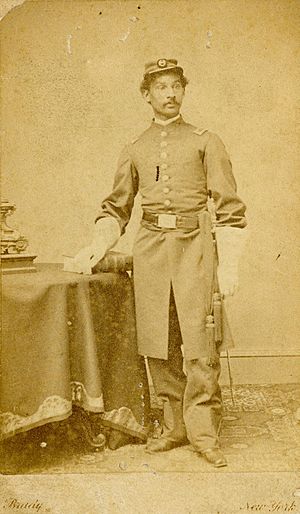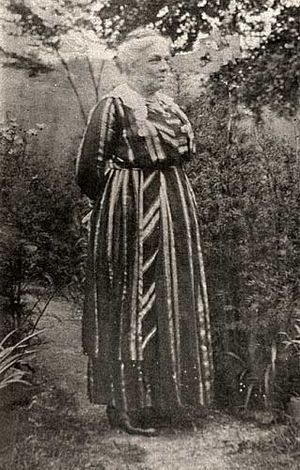Anderson Ruffin Abbott facts for kids
Quick facts for kids
Doctor Anderson Ruffin Abbott
|
|
|---|---|
 |
|
| Born | April 7, 1837 |
| Died | December 29, 1913 (aged 76) Toronto, Ontario, Canada
|
| Nationality | Canadian |
| Other names | Doctor Abbott |
| Education | University of Toronto |
| Occupation | Doctor of Medicine |
| Spouse(s) | Mary Ann Casey |
| Children |
|
| Parent(s) | Wilson Ruffin Abbott and Ellen Toyer |
| Relatives | Frederick Langdon Hubbard (son-in-law) |
Anderson Ruffin Abbott (born April 7, 1837, died December 29, 1913) was a very important person in Canadian history. He was the first Black Canadian to become a licensed doctor. He also played a part in the American Civil War. Later, he held important jobs like coroner in Kent County, Ontario, and even became a chief surgeon.
Early Life and Education
Anderson Abbott was born in Toronto on April 7, 1837. His parents were Wilson Ruffin and Mary Ellen Toyer Abbott. They were Americans of African background. The Abbott family was well-known in Toronto. They had moved from Alabama as free people of colour. They left Alabama after being warned that their store might be attacked.
After living briefly in New York, they settled in Upper Canada around 1835 or 1836. Anderson's father, Wilson Abbott, became very successful. He bought a lot of land in and around Toronto. By 1871, he owned 48 properties. Wilson Abbott also became active in politics.
Because his family was successful, Anderson Abbott received an excellent education. He went to both private and public schools. One school was run by William King in the black Elgin settlement (now North Buxton, Ontario). Anderson was an honour student at the Toronto Academy. He later attended Oberlin College in Ohio, in the United States.
He returned to Canada in 1857. He then studied at University College in Toronto. In 1858, he became a medical student at the Toronto School of Medicine. He learned from Alexander Thomas Augusta, a Black doctor from the U.S. Anderson Abbott did not officially graduate from the university. However, he received a license to practice medicine in 1861. This made him the first Canadian-born Black doctor.
A Doctor's Important Career
In 1866, Dr. Abbott left his service with the Union Army. He returned to Canada. The next year, he took more medical classes at the University of Toronto. Even though he didn't graduate, he opened his own medical practice. In 1871, he was accepted into the College of Physicians and Surgeons of Ontario.
On August 9, 1871, he married Mary Ann Casey in Toronto. She was 18 years old and the daughter of a successful Black barber. Dr. Abbott and his wife moved to Chatham, where he continued his medical work. They had three daughters and two sons.
Like his father, Dr. Abbott became an important leader in the Black community in Toronto. From 1873 to 1880, he worked hard to stop racially segregated schools. He was the president of the Wilberforce Educational Institute. In 1874, he became the coroner for Kent County, Ontario. He was the first Black man to hold this important job.
Dr. Abbott also wrote for a local newspaper called the Chatham Planet. He was also an editor for the Missionary Messenger. This was a journal for the local British Methodist Episcopal Church. In 1878, Dr. Abbott became president of both the Chatham Literary and Debating Society and the Chatham Medical Society.
In 1881, Dr. Abbott moved his medical practice to Dundas, Ontario. There, he also took on important community roles. He was a trustee for the high school. He also chaired the town's internal management committee from 1885 to 1889. He also worked as an administrator for the Dundas Mechanics' Institute.
The Abbott family moved to Oakville, Ontario, in 1889. But they returned to Toronto the next year. Dr. Abbott became a member of the Grand Army of the Republic. This was a group for Civil War veterans. He was one of 273 Civil War veterans in Toronto to wear their special badge. He was known as "Captain Abbott." This title might have been from his role in the Grand Army of the Republic.
In November 1892, Dr. Abbott received a very high honour. He was appointed aide-de-camp on the Staff of the Commanding Officers Dept. of New York. This was a source of great pride for his family. It was the highest military honour given to a Black person in Canada or the United States at that time.
In 1894, Dr. Abbott became surgeon-in-chief at Provident Hospital in Chicago. This was the first training hospital for Black nurses in the United States. He became the hospital's medical superintendent in 1896. He left the hospital the next year.
Returning to Toronto, Dr. Abbott continued his private medical practice. He also wrote more for different publications. These included The Colored American Magazine and the Anglo-American Magazine. For the Anglo-American Magazine, he wrote about "Some recollections of Lincoln's assassination." He also wrote for the New York Age. His writings covered many topics. These included medicine, Black history, the Civil War, and poetry.
Later Years and Legacy
Around the year 1900, Dr. Abbott became involved in a discussion about social change. He believed that Black people needed access to higher education. He thought this was very important and should not be limited.
Dr. Abbott believed that Black people would eventually become part of the larger culture. He wrote that it is natural for two groups of people living together to mix. He thought this was especially true in Canada. He believed that over time, the "colour line" would disappear in Canada.
Death
Anderson Ruffin Abbott died in 1913. He was 76 years old. He passed away in Toronto at the home of his son-in-law, Frederick Langdon Hubbard. Frederick Hubbard was the chairman of the Toronto Transportation Commission from 1929 to 1930. He was also the son of Dr. Abbott's long-time friend, William Peyton Hubbard.
Dr. Abbott is buried in the Toronto Necropolis. His daughter, Grace (Abbott) Hubbard, gave his historical papers to the Toronto Public Library in 1963. Some of these papers have been put online. The rest can be found at the Toronto Reference Library.
See also
 In Spanish: Anderson Ruffin Abbott para niños
In Spanish: Anderson Ruffin Abbott para niños


